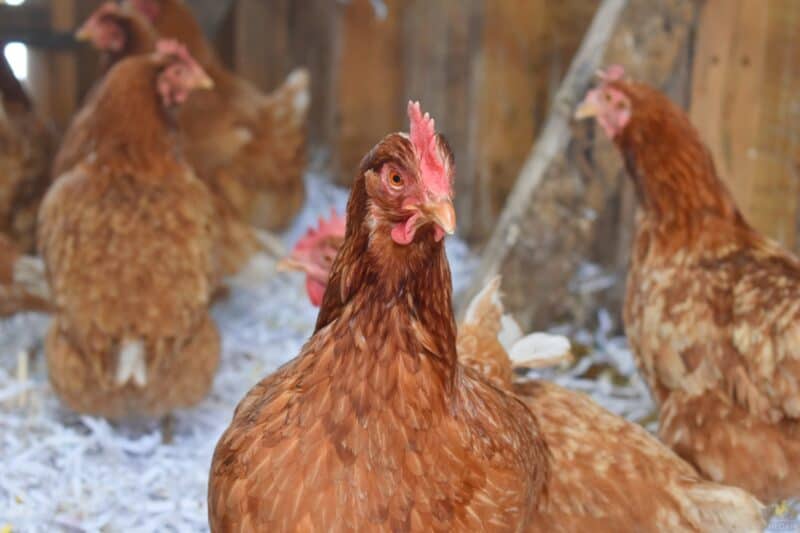Foxtail grasses are those that rely upon spiny clusters as seed dispersal mechanisms. Various species grow all across North America and are known for being a significant nuisance plant.

However, chickens can eat all sorts of grasses, weeds and other pesky plant matter. So can our chickens eat foxtail?
No, chickens should not be allowed to eat foxtail in any form. Although not poisonous, the seeds of foxtail are notorious for lodging themselves and soft tissues and penetrating deeper over time. The risk of injury, infection and death from foxtail grasses is significant.
The hazards opposed by foxtail grasses, barleys and other plants in this category can range from nuisance to substantial, and for that reason you must take pains to prevent your chickens from eating or interacting with them.
Keep reading to learn everything you need to know about foxtail grasses and chickens.
Foxtail Can be a Persistent Danger for Chickens
For those who are unacquainted with foxtails, it might come as a shock when you learn just how perilous they can be, especially for animals which lack the hands and overall dexterity of humans.
First things first, foxtails all get their name because they feature a method of seed dispersal that relies upon clusters of what are commonly known as spikelets which carry their seeds.
These spikelets are topped by a dense, hard tip known as a callus.
This callus is covered with barbs arranged in retrograde fashion, much like the tines of a fishing hook or spearhead.
When the grasses are disturbed, the spikelets carrying the seeds lodge into the fur, feathers or most worryingly into the flesh of any animal or person passing by.
With activity and pressure, these barbed spikes dig deeper and deeper into the fur or into the tissues of the animal carrying them.
For the plant, with some luck the seeds will eventually dislodge and fall to the ground, but much of the time, and humans and domestic animals, they must be removed before they become a problem.
Effects of Spikelet Penetration
Foxtail spikelets are a constant health hazard for domestic animals in areas where they are found.
Much of the time, the spikelets will pass the fur or feathers and start to penetrate the body of unfortunate animals that come into contact with them.
They are also notorious for becoming stuck in body openings such as the nostrils, ears, mouth and soft tissues around the eyes.
If ingested, they are particularly likely to become stuck in the throat or crop of chickens. Once these spikelets have become embedded in tissue, there are a few possible outcomes.
Swelling is certain and infection possible, but depending on the location of the spikelet it might be encapsulated in a cyst and degrade over time.
However, serious injury can result when the spikelets burrow ever deeper and impinge upon organs or major blood vessels.
Common serious injuries are ruptured eardrums resulting from spikelets getting into the ear canal or major damage to the sinuses when inhaled through the nose.
Removal of spikelets that go any deeper than the superficial level requires a medical intervention.
I hope you understand by now why you should never allow your chickens to eat any foxtail grasses or barleys, and you should take pains to keep them away from areas where these grasses are present.
Can Chickens Eat Foxtail Raw?
No, chickens should not eat foxtail grass or barleys raw under any circumstances.
Can Chickens Eat Foxtail Cooked?
No. Cooking might serve to soften or potentially even destroy the barbs on a foxtail spikelet, but this is uncertain and you shouldn’t risk it.
Eradication of Foxtail Must be Done with Thoroughly to Eliminate the Threat
Freeing your chickens from the dangers of foxtail spikelets is mostly a matter of careful inspection, paying close attention to the condition of their feathers along with inspecting beneath thicker plumage for any that might have reached the skin.
Pay particular attention to their feet, waddles, combs and areas around the eyes. Chickens that seem to show difficulty or distress when eating but are not showing any signs of poisoning should be carefully inspected for possible ingestion of foxtails spikelets.
Getting rid of a foxtail plants in your area might prove to be quite challenging.
Many proof it resistant to common herbicides, and attempting to remove them via mechanical methods, i.e. pulling them up, might serve only to disturb the ground and dislodge more seeds, leading to an increased regrowth next season.
Covering them up with mulch, bark or something else in an attempt to choke them out usually proves unsuccessful too.
Be especially cautious if you bush hog an area where foxtail grasses grow, and don’t let your chickens eat from the pile as they might ingest the spikelets.
Baby Chicks are Particularly Vulnerable to Foxtail
It should be pointed out that baby chicks are particularly vulnerable to the spikelets from foxtail.
Their lower body mass combined with downy soft feathers means that the spikelets can reach their tissues far more quickly, and it takes comparatively less penetration for serious injury to be inflicted.
You must always keep a close eye on your chicks for any problems, but pay particular attention if you have foxtail grasses in the area.
Their mothers usually do a pretty good job of keeping them groomed, but if mom manages to pull off a spikelet and then swallows it she could be in as much trouble as her young!
Tom has lived and worked on farms and homesteads from the Carolinas to Kentucky and beyond. He is passionate about helping people prepare for tough times by embracing lifestyles of self-sufficiency.
